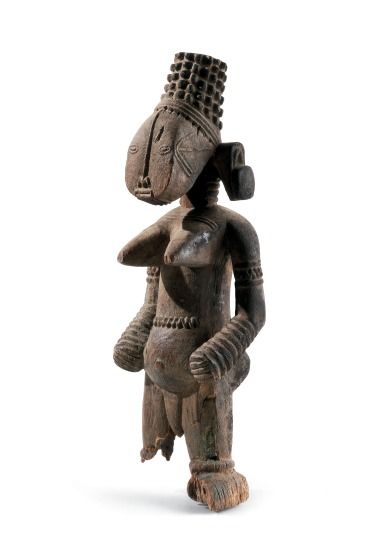“Central Nigeria Unmasked” at the African Art Museum
A landmark new exhibition takes visitors on a tour through the world of African art
/https://tf-cmsv2-smithsonianmag-media.s3.amazonaws.com/filer/20110916103004yukuben-mask-small.jpg)
Arnold Rubin, a legendary researcher of African Art at UCLA, spent decades doing fieldwork in Nigeria’s Benue River region. As he discovered the incredible range and beauty of traditional Benue art, he dreamt of creating a comprehensive exhibition to unite the pieces of work that had drifted around the world to various collectors. When he died in 1988, his protégé, Marla C. Berns, decided to take up the mantle.
Opening this week at the African Art Museum, “Central Nigeria Unmasked: Arts of the Benue River Valley” is the show Rubin long imagined. “We really looked far and wide to find objects that would be able to tell the story of the history of central Nigeria,” says Berns, who led a preview tour this week. As the director of UCLA’s Fowler Museum, Berns was instrumental in organizing and curating the landmark collaborative exhibition between museums. With carvings, masks, statues and other ritualistic artifacts, representing 25 different communities along the Benue River—on loan from 47 different private and public collections—the show is nothing less than a sweeping survey course in Nigerian art.
The Benue River is a crucial pathway for both transportation and cultural flow through Nigeria. “We decided to use geography as the primary organizing principle,” Berns says. “It’s as if you were following the ways in which Europeans encountered the river, which is against its flow.” Museumgoers encounter the river’s Lower, Middle, Upper Benue areas, in galleries filled with works that vary between the regions but also exemplify the influences shared between the groups of peoples living throughout the valley.

The works are simultaneously stunning and unnerving with several depicting an unexpected mixture of human forms with animal characteristics. But what makes many of them so interesting is the way their stylized design reflects the rituals of life throughout the Benue Valley. An enormous elephant mask at the center of the exhibition, which required four staffers to lift it into place in the gallery, was customarily used to demonstrate power. “The elephant is a metaphor for the chief, the chief being the most powerful person in the community, as the elephant is the most powerful animal in the forest,” Berns says. “The masquerades were performed on various occasions to celebrate the power of the chief himself.”
Other examples of traditional culture include wooden representations of animals that were successfully hunted and which were used to prevent the animal’s spirit from seeking revenge. Zigzagging metal wands that resemble both the jagged path of lightning in the sky and the wriggle of snakes before an approaching storm were used to beckon rain for the crops.
From the Upper Benue are a number of ceramic healing vessels, likely made by the Chamba peoples. “They would say an invocation in an effort to draw the disease out of you, into the clay,” Berns says. “That piece of soft clay is then incorporated into a vessel, which is fired, and the illness is thought to move from the person into the pot.” Each vessel’s design is slightly different, revealing the symptoms healers sought to cure. “This pot, with its long form, was used to cure vomiting, in a kind of emulation of the body gesture involved.”
Scattered throughout the exhibition are video screens, showing many of these rituals in action with objects similar to those on display. The show focuses on works made between the late 19th and late 20th centuries. Some of the customs have been abandoned, but many others have been adapted to fit these communities’ modern social context.
“We produced these videos because it was very important to us that people have a chance to see this part of Nigeria, to see the people who live there, to understand that we’re not dealing with deep history but rather from recent history,” says Berns.
These works are not just reflections of a rich cultural history—they also impart significant information about dynamic traditions thriving yet today. “These art forms maintain their relevance, largely because many have been transformed into forms of entertainment and cultural identity,” Berns said. “They are ongoing, living and breathing traditions.”
“Central Nigeria Unmasked: Arts of the Benue River Valley” will be on display at the African Art Museum through March 4, 2012
/https://tf-cmsv2-smithsonianmag-media.s3.amazonaws.com/accounts/headshot/joseph-stromberg-240.jpg)
/https://tf-cmsv2-smithsonianmag-media.s3.amazonaws.com/accounts/headshot/joseph-stromberg-240.jpg)